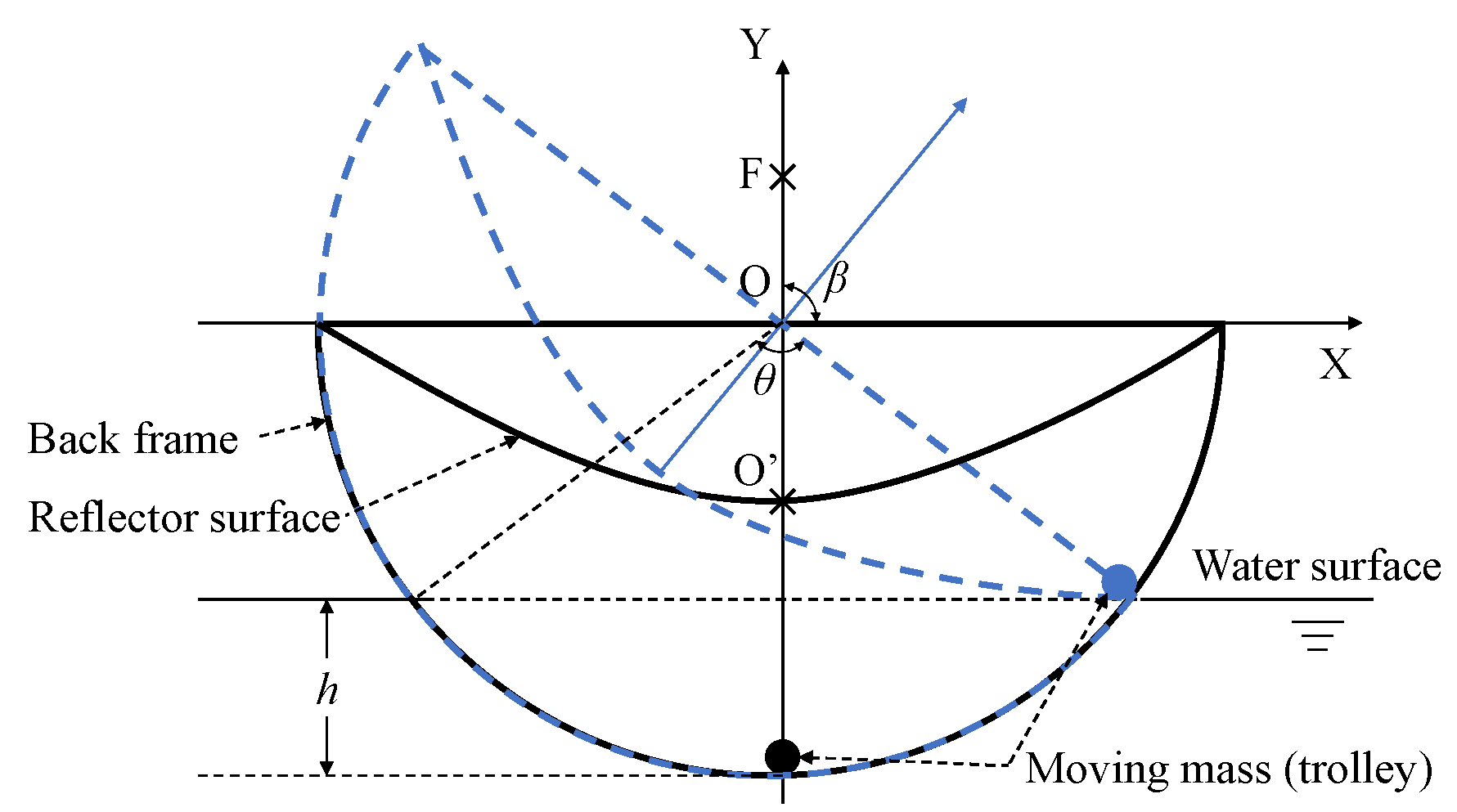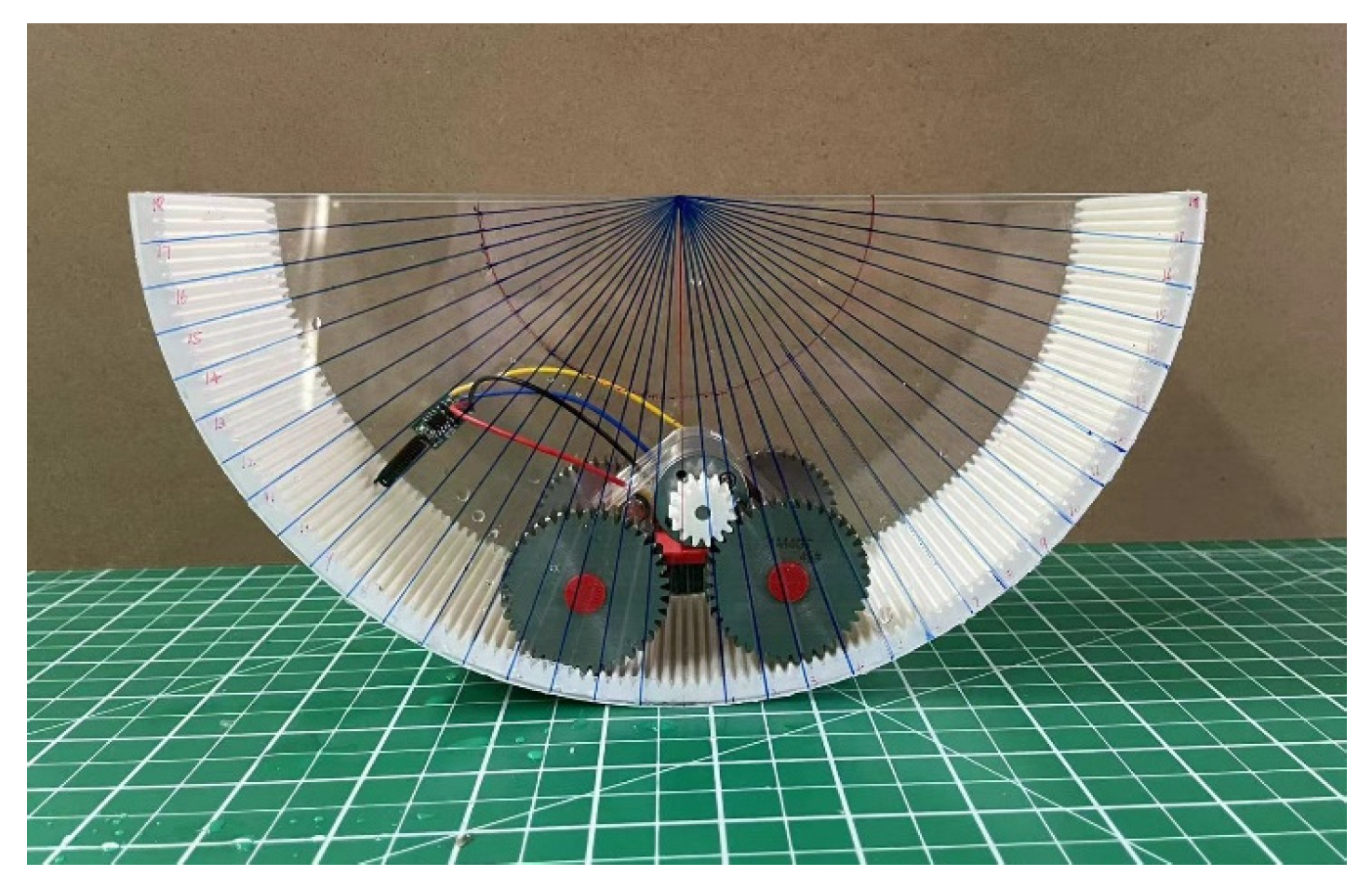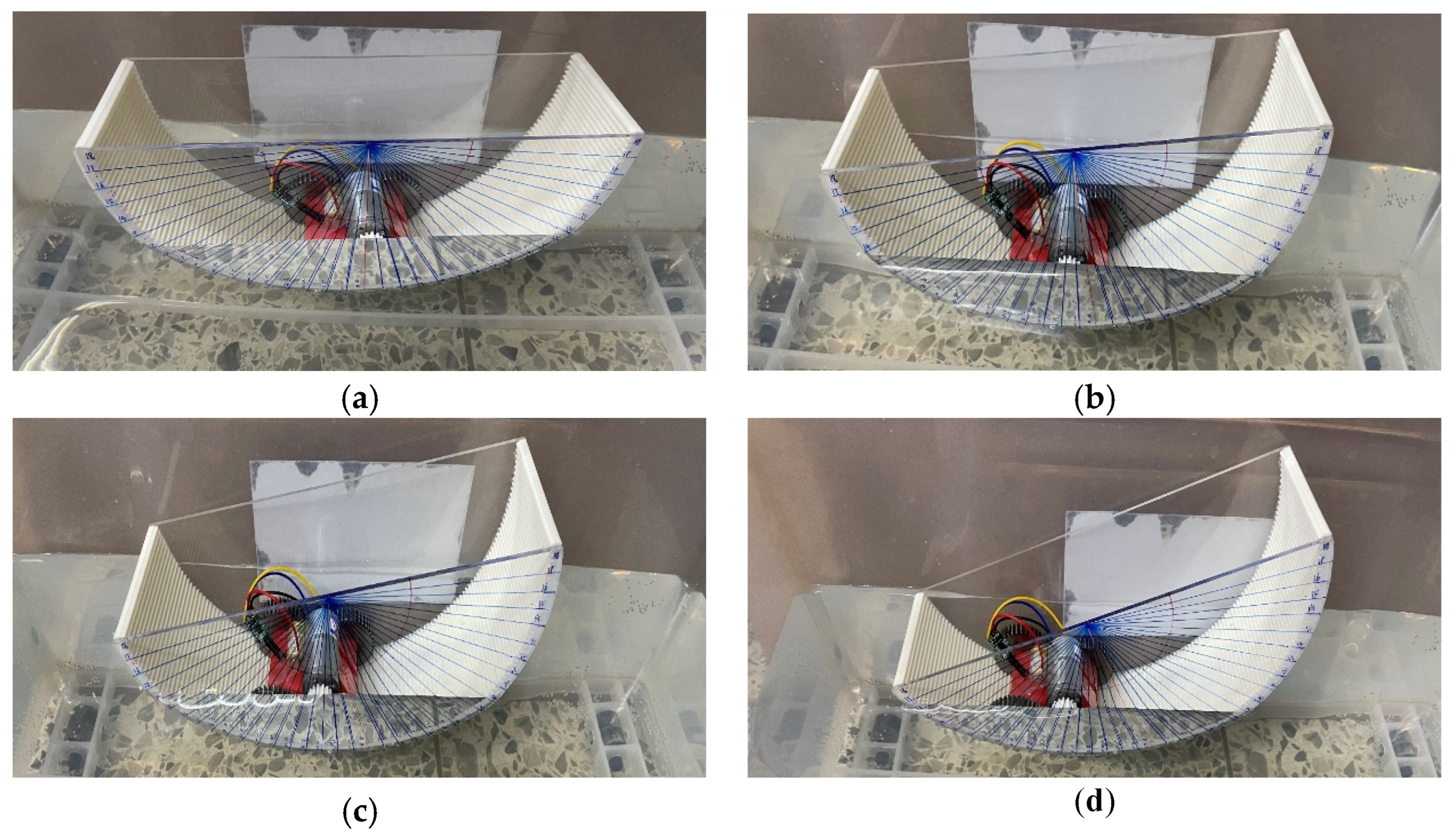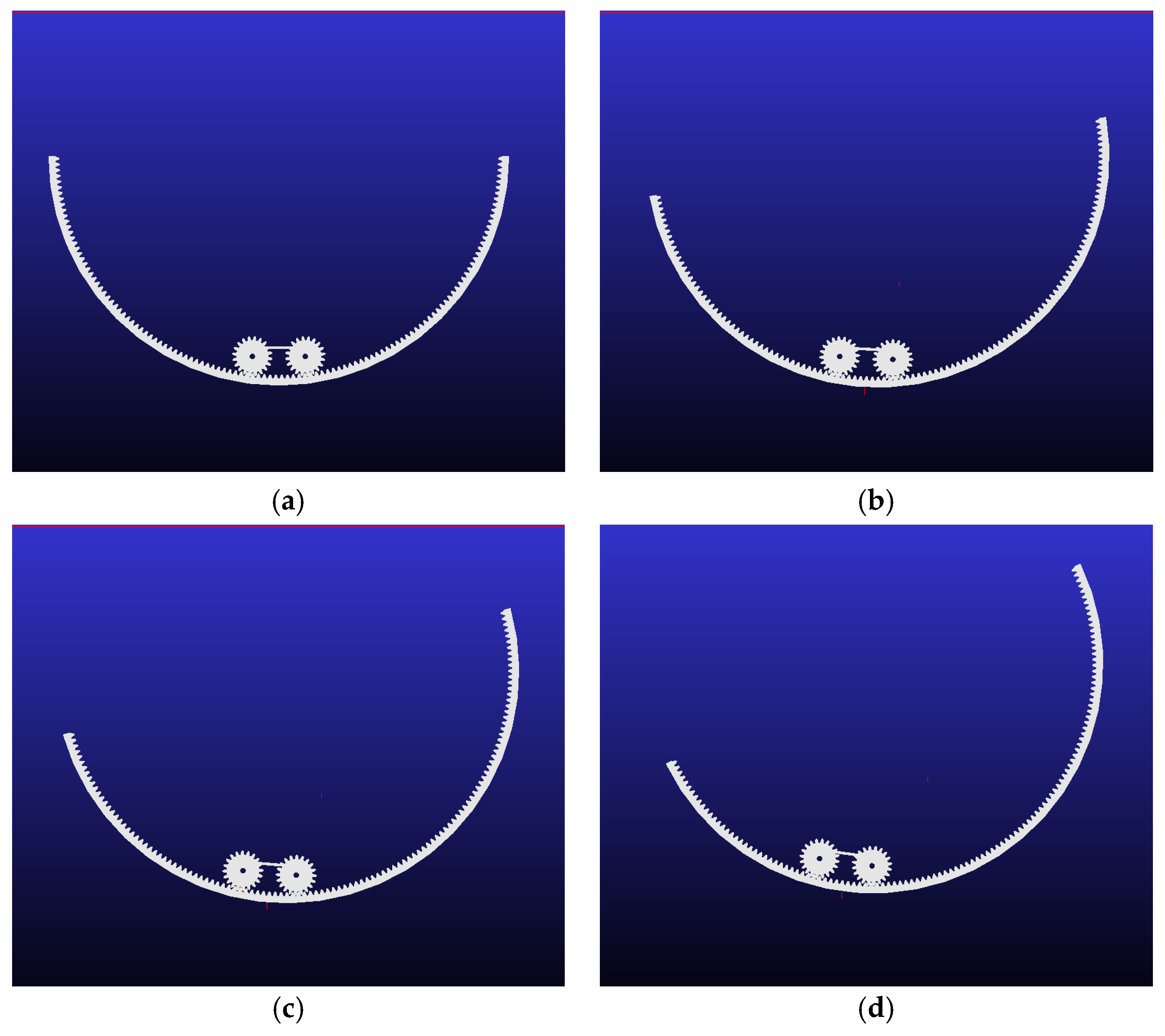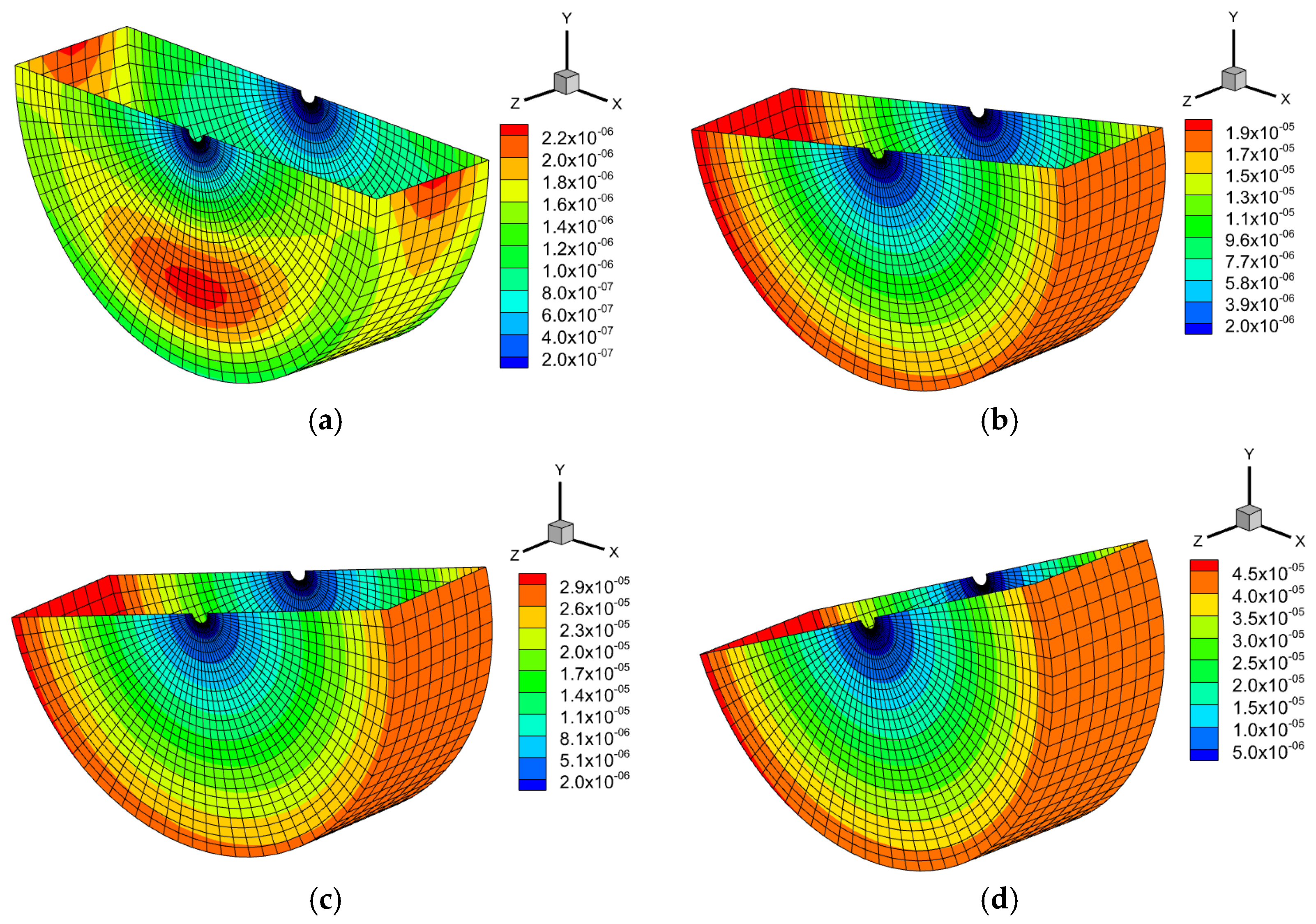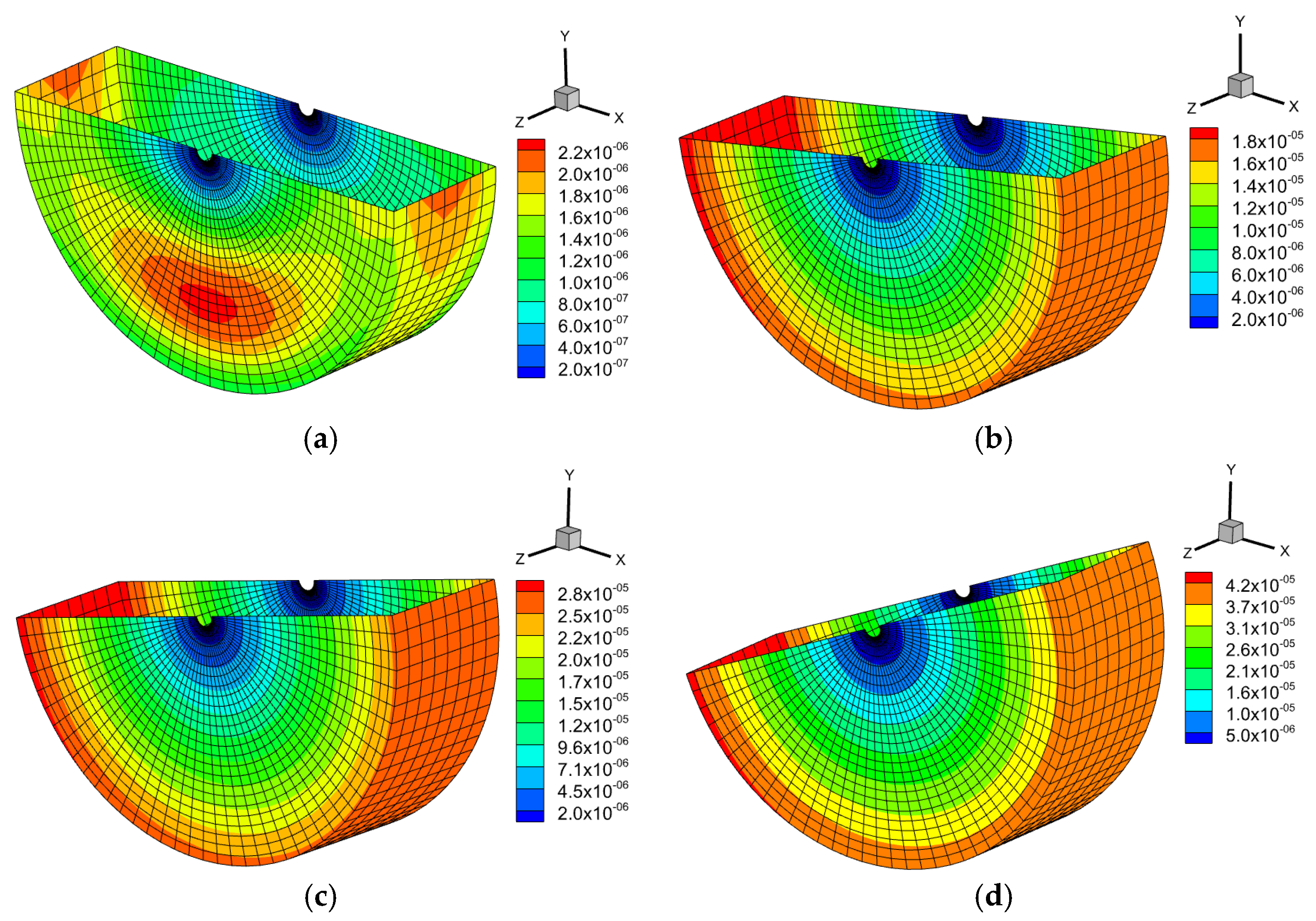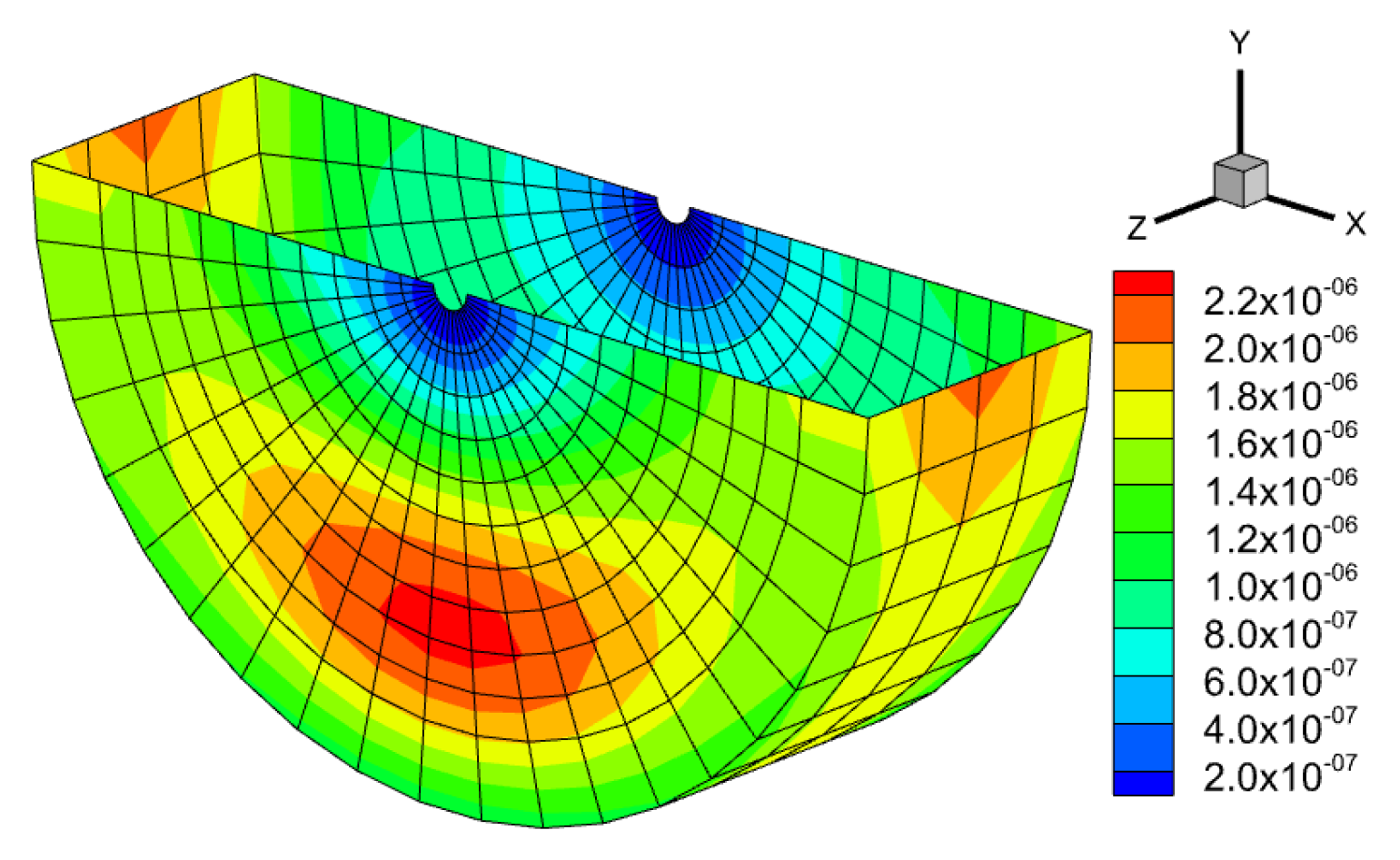1. Introduction
Reflector antennas have been applied to satellite communication, remote sensing, and radio astronomy for decades [
1,
2,
3,
4]. Radio astronomy detection is mainly carried out with single-aperture radio telescopes or interference array antennas. The antenna array can be composed of various antennas such as parabolic cylindrical reflector antennas, parabolic reflector antennas, and dipole oscillator arrays. Among these antennas, the large parabolic cylindrical reflector antenna is favored by more and more researchers due to its unique advantages such as high gain, strong directivity, and multiple feeds [
5]. Since the 1950s, many countries have built a number of typical cylindrical reflector antennas in succession, such as the Ooty Radio Telescope [
6], the Molonglo Observatory Synthesis Telescope of Australia [
7], and the Nagoya IPS Stations of Japan [
8]. China has also proposed a specific experimental prototype of the parabolic cylindrical reflector antennas in the Tianlai Project [
9]. Some scholars have carried out the structural design and mechanical analysis of these parabolic cylindrical reflector antennas [
10]. In 2015, China built an antenna array for dark energy detection that consisted of three 45 × 15 m parabolic cylindrical reflector antennas and sixteen parabolic reflector antennas [
11]. All of these illustrate that there are broad development and application prospects for parabolic cylindrical reflector antennas.
Parabolic cylindrical reflector antennas can be divided into fixed antennas and movable antennas according to different observation objects [
12]. The feed of the movable antenna is fixed to the reflector surface through brackets. Then, the reflector surface is mounted on the pitch axis through the back frame structure. Generally, the weight of an antenna is roughly proportional to the square of the aperture for movable antennas [
13]. In comparison with the fixed antenna, the movable reflector antenna can observe more signal sources and track a single signal source for a longer time. With increasing demands of observation, the aperture of the antenna becomes larger, which is followed by some challenges in mechanical rotation [
14,
15,
16], feed support [
17], and structural weight [
18]. Furthermore, excessive weight brings great challenges regarding the construction process and production cost. It also causes a negative impact on the service life of reflector antennas. For example, since the start of its observations in 2001, the azimuth track of the Green Bank Telescope (GBT) has presented a series of problems due to its heavy weight and insufficient design, including tangential slippage of the base and wear plates, excessive tilting of the azimuth wheels, surface deterioration between the wear and base plates, fatigue fracture of bolts, cracks in wear plates, and so on [
19,
20,
21].
Based on the background above, it has been stated that the huge weight of a large-aperture reflector is a critical challenge to the mechanical mechanism of movable antennas, which appeals to numerous scholars. Some scholars have committed to developing the design of mechanical systems and actively adjusting the reflector surface to improve the working performance [
22,
23,
24]. Alternatively, some scholars have proposed some optimization ideas to reduce the weight and construction cost of reflector structures [
25,
26,
27]. Most studies regard the movable reflector antenna on the ground. The gravity of the superstructure is concentrated on the azimuth mechanism, resulting in the range of problems mentioned above. In contrast, the movable reflector antenna set on the water surface can effectively resist the influence of gravity through buoyancy. Nevertheless, to the authors’ knowledge, there are few studies on this [
28].
Hence, a floating cylindrical reflector antenna (FCRA) is put forward in this study based on the current research. The buoyancy of water can resist the gravity of the structure. Then, the elevation angle of the reflector surface can be adjusted via the position change of the gravity center based on the moving mass inside the FCRA. The moving mass control has been studied on the roll control of flexible aircraft and the deformation control of flexible wings [
29,
30]. Hence, a moving mass gear drive method was adopted here to control the elevation angle adjustment for the reflector. There are several advantages of FCRAs. The vast ocean space can be utilized to expand the sites of this movable reflector antenna. It can be combined with existing radio telescopes on land to form a very long baseline interferometry (VLBI) network. Furthermore, the size of a VLBI network can be extended to the scale of the Earth’s diameter with the good mobility of an FCRA. Thus, a better observation performance can be obtained, and more signal sources can be tracked.
Further, in consideration of the effect of structural deformation on reflector accuracy, it is necessary to perform structural health monitoring (SHM) for the back frame structure of an FCRA. Known as shape sensing, the reconstruction of full-field structural deformation is a key component of SHM by utilizing discrete in situ strain measurements. Tessler and Spangler [
31] developed a computationally efficient methodology called the inverse finite element method (iFEM) for the purpose of performing accurate shape sensing of plate and shell structures by using a three-node triangular inverse-shell element (iMIN3). The proposed method is based on a least-squares variational principle to reconstruct the full-field deformation from measured surface strains. Subsequently, more types of elements have been developed based on the work of Tessler, such as the four-node inverse-shell element (iQS4) [
32] and the inverse beam–frame element [
33]. Regarding the application of iFEM, it has been utilized in an offshore structure [
34], a cantilever plate [
35], a wing frame [
36], a wind turbine tower [
37], and so on. Numerous investigations have demonstrated the unique suitability of iFEM in terms of structural deformation monitoring. However, regarding the SHM of the back frame structure during the angle adjustment process, there is little research on the deformation reconstruction for the complex structure with over-constraints under a mechanism motion process.
In this paper, a new FCRA driven by a moving mass is developed using parametric design. The mechanism behaviors of this FCRA are analyzed via the mutual verification of the theoretical model, software simulation, and a prototype test. The shape sensing of the back frame is carried out via iFEM methodology to reconstruct the three-dimensional displacement of the over-constrained structure during the angle adjustment process by using several quasi-static sampling moments. The paper is organized as follows. The structural design of the FCRA is introduced in
Section 2. Then, the non-dimensional design parameters, kinematic relationship, water surface constraint, and structural stability are analyzed in
Section 3. The elevation angle adjustment process is studied by using a prototype model test and software simulation in
Section 4. Further, the iFEM algorithm based on the iQS4 element is briefly reviewed, and the deformation analysis and shape sensing for the back frame of the FCRA are carried out in
Section 5. The conclusions are provided at the end of
Section 6.
3. Parameter Analyses
Some parameters are defined and analyzed to explore the relationship between the elevation angle adjustment and the trolley rotation. The influence of each variable on the rotation capacity and the structural stability of the FCRA is investigated below.
3.1. Parameter Definitions
The radius of the reflector surface is defined as R. The longitudinal length of the FCRA is L. The back frame shell thickness is t. The total track width is L1 and the track thickness is t1. The density of water and the density of the back frame are ρw and ρ, respectively. The FCRA mass m is divided into several parts, which are side plate masses mn, semi-cylindrical shell mass ml, track masses mt, and trolley mass ms. The first three parts constitute the mass of the back frame, which is defined as mc = mn + ml + mt. These masses of each part in the back frame can be calculated as mn = πR2tρ, ml ≈ πRtLρ, and mt ≈ πRt1L1ρ, respectively.
Assuming that the aperture
D of the FCRA is 500 mm, the initial values of each design parameter are listed in
Table 2 based on the model in
Section 2, while reflector radius
R and water density
ρw are kept constant as their initial values. To easily study the effects of these parameters, the control variables are defined as the non-dimensional variables in
Table 3.
3.2. Kinematic Relationship and Water Surface Constraint
The intersecting surface of the cylindrical paraboloid reflector is simplified into a parabola located in 2-dimensional Cartesian coordinate system XOY of
Figure 2, the function of which is defined as
pz =
x2 +
q. It is assumed that the origin O is set up at the circle center of the semi-cylindrical shell. The Z axis is perpendicular to this plane by the right-hand rule. The trolley is simplified as a moving mass.
Since the FCRA is placed directly on the water, the immersion depth
h into the water’s surface is expressed by the central angle
θ of the arc under the water’s surface (
Figure 2) as
As simplified in the XOY plane, the reflector motion is indicated by the elevation angle
β between the focal diameter O’F and axis X, where points O’ and F are the vertex and focus of the reflect parabola, respectively, in
Figure 2. The trolley is located at the center of the track while the focal diameter O’F of the reflector in the upright state coincides with axis Y of the global coordinate system in
Figure 2.
To declare the relationship between the moving mass position and the reflector elevation angle, the FCRA motion process only considering the rigid body kinematics is divided into two stages as shown in
Figure 3, namely moving mass motion and structure rotation.
Assuming that the back frame structure is immobile at the first stage in
Figure 3a, only the motion of moving mass relative to the track is taken into account. The relative motion angle between the moving mass and the track is defined as
γ.
At the second stage, the back frame structure is released to rotate around the central axis until there is an equilibrium for the whole structure. The elevation angle
β of the reflector and the position of the moving mass are shown in
Figure 3b. There is a torque equilibrium equation as
mcRcsin
φ = msRssin
α. Substituting the non-dimensional variables, it is expressed as
Appendix A Equation (A1), where
φ is the angle between axis Y and the focus diameter O’F in the equilibrium.
α is the angle between the equilibrium position and initial position of the moving mass. The left and the right terms are the torque generated by the gravity of the back frame and the moving mass, respectively. The back frame centroid position
Rc along the radial is written as
Appendix A Equation (A2). In accordance with the geometric relationship in
Figure 3, relative motion angle
γ and the elevation angle
β have relationships with the rotation angle
φ and
α as
α +
φ =
γ and
β +
φ = 90°. Then, the torque equilibrium equation can be rewritten as
Appendix A Equation (A3). Then, the elevation angle
β is expressed as
According to the expression β = 90° − φ, the reflector in the upright state of β = 90° becomes horizontal along with the enlargement of φ and the reduction of β. Therefore, the upper-limit βmax is 90° while the lower-limit βmin depends on the rotation angle φ of the FCRA.
The rotation capacity is directly limited by the immersion depth
h of the FCRA into the water’s surface as shown in
Figure 2 and
Figure 3b. This critical state of rotation capacity
φ is determined as the position (
Figure 2) of the back frame end reaching the water’s surface. It means that this
βmin is equal to the half central angle of the arc under the water’s surface, namely
θ/2. According to the Archimedes principle, the relationship between the gravity of the FCRA and the volume of water discharge can be written as
mg = ρwgVd = ρwgLR2(
θ − sin
θ)/2. It is expressed by non-dimensional variables as shown in
Appendix A Equation (A4). Substituting
βmin into
Appendix A Equation (A4), it can be reduced as
Particularly, the smaller total weight m becomes, the smaller lower-limit βmin and the larger rotation capacity φ of the FCRA can achieve.
In addition, the rotation capacity meets the kinematic relationship between reflector elevation angle adjustment and moving mass rotation, namely Equation (2). Since the reflector elevation angle β turns into the lower-limit βmin under the constraint of Equation (3), the relative motion angle γ becomes larger based on Equation (2). In general, the lower-limit βmin represents the rotation capacity of the FCRA. The lower βmin becomes, the larger the rotation capacity and elevation angle adjustment range, which means that the observation signal range of the FCRA is wider.
3.3. Structural Stability
Considering that the FCRA is located on water like ships [
38,
39], the structural stability should be guaranteed to avoid capsizing. Herein, only the transverse stability and initial stability are investigated with respect to the structural characteristics and working requirements. Assuming that a small heel angle
δ occurs as shown in
Figure 4, G, B, and B
1 are the centers of gravity, buoyancy without heeling, and buoyancy with a slight heeling angle. According to the position of G and B
1, it can be seen that the condition GBsin
δ < BB
1 can return the equilibrium under its own restoration moment after the heeling.
Before the FCRA heels, combining with
Appendix A Equation (A4), the distance between the center of gravity and the initial floating center is calculated as
Appendix A Equation (A5). It should be mentioned that the position of G may be lower than the position of B when the mass of the trolley accounts for a large proportion of the mass of the FCRA. In this case,
Appendix A Equation (A5) is still valid for the stability of the FCRA.
After the FCRA has a slight heeling, in accordance with the principle of the center of gravity movement and
Appendix A Equation (A4), the distance of the floating center movement can be written as
Appendix A Equation (A6). Then, the condition to ensure the FCRA is restored to the horizontal floating state with the heeling angle
δ can be described as
Appendix A Equation (A7). It can be approximated that cos
δ ≈ 1. Then, the stability parameter
S is defined as
Hence, the stability of the FCRA increases with the increase in the value of S, which indicates the restorability of the FCRA when a small heeling occurs.
3.4. Parameter Study
The initial values of each design parameter and corresponding non-dimensional variable are kept the same as listed in
Table 2 and
Table 3. The ranges of these non-dimensional control variables are consistent with the range in
Table 3.
To investigate the relationship of these variables with the lower-limit
βmin and the stability parameter
S, univariate curves of each non-dimensional parameter are drawn in
Figure 5 based on Equations (3) and (4) while the rest of the variables are constants listed in
Table 3.
In
Figure 5, it is obvious that only the variable
b corresponding to longitudinal length has a negative correlation with the lower-limit
βmin, and the other variables are positively correlated with the lower-limit
βmin. By selecting reasonable values of these parameters, the lower-limit
βmin can be controlled below 50° so that the rotation range is about 0° to 40°. Comparing the change in the lower-limit
βmin in
Figure 5, it can be seen that shell thickness
a, the ratio of the trolley mass to FCRA mass
c, and back frame density
n have great influence on the lower-limit
βmin with the differences as high as 40°, while the influence range of the others is somewhat small.
Figure 5a,e represent that the effect of shell thickness
a on the lower-limit
βmin is greater than track thickness
a1 when
a and
a1 are in the same range. Longitudinal length
b has a greater influence on the lower-limit
βmin than total track width
b1 as illustrated in
Figure 5b,f. Additionally, the lower-limit
βmin becomes better with the increase in longitudinal length
b while the lower-limit
βmin becomes worse with the increase in total track width
b1.
There is positive correlation between these parameters and stability parameter
S except the ratio of the trolley mass to FCRA mass
c in
Figure 5. There is transition in the curve of
c and
S as illustrated in
Figure 5c. The corresponding value of
S in the transition phase is below zero, which means that the value of
c cannot meet the stability requirements (refer to Equation (4)). In addition, the value of
c in the ascending phase is invalid as the value of
βmin cannot exceed 90°. In
Figure 5, longitudinal length
b and back frame density
n have great influence on structural stability, followed by shell thickness
a, the ratio of trolley mass to FCRA mass
c, and total track width
b1, and track thickness
a1 has the least influence on structural stability.
In summary, on the basis of ensuring the stability of the FCRA, the optimal parameter combination for obtaining the maximum rotation capacity of the FCRA is a = 0.02, b = 2, c = 0.3, n =1, a1 = 0.02, and b1 = 0.4.
5. Deformation Analysis and Reconstruction
The deformation analyses of several specific rotation states corresponding to the rotation process of the prototype model test are carried out. The algorithm iFEM is performed for deformation reconstruction of the back frame.
5.1. Inverse Finite Element Method
The core of the iFEM algorithm is to construct an inverse element and construct the error functional between the analytical strain and measured strain based on the inverse element. The purpose of reconstructing the structural deformation is realized by finding the minimum value of the functional. Kefal et al. [
32] developed a four-node inverse quadrilateral shell (iQS4) element which has six degrees of freedom (DOFs) per node as shown in
Figure 10. Then, the element nodal displacement vector
ui = [
ui1 ui2 ui3 ui4]
T can be expressed as
uiq = [
uq vq wq θxq θyq]
T, (
q = 1, 2, 3, 4).
According to the linear strain–displacement relations and the plane-stress assumption
σz = 0 within the implication that the transverse-normal strain
εzz does not contribute to the strain energy, the strain components can be combined to describe the membrane strain
e(
ui), bending curvatures
k(
ui), and transverse shear strain
g(
ui). Then, the strain–displacement relations are described as
The deformation reconstruction based on the iFEM algorithm requires the surface measurement strain data. Considering the discrete strain measurement method shown in
Figure 11, the strain sensors are arranged on the top and bottom surfaces of the structure.
The measured membrane strains
eε and bending curvatures
kε that correspond to their analytic counterparts
e(
ui) and
k(
ui) given by Equation (5) can be determined from the measured surface strain as
The key formulas of the iFEM algorithm are derived from the extreme value of the least-squares functional between the analytical strain in Equation (5) and measured strain in Equation (6). In terms of the iQS4 element, the functional takes the form as
The unknown variable of the functional is the element nodal displacement vector
ui. With regard to the variational principle and after some mathematical deduction, the condition for the minimum value of the function can be simply expressed as
Since the contribution of gε is much smaller than eε and kε, it can be neglected in the calculation. With the nodal displacement vector transformed from the local coordinate to the global coordinate and the standard finite element integration operation, the element matrix of discrete structure is assembled into a linear equation. Furthermore, by imposing the displacement boundary conditions such that the matrix K is non-singular, the iFEM equation can be solved to obtain the unique solution. Since the matrix K only depends on the mesh discretization and the sensor distribution, it only needs to be calculated once. And the matrix F is dependent on the measured strain values, thus, it needs to be updated at each time step during calculation.
5.2. Deformation Analyses
The aforementioned prototype model test has been analyzed and verified for the rigid body motion of the FCRA. Herein, the panels and shell of the back frame are taken for flexible deformation analysis. According to the physical size of the prototype model, the diameter of two side panels and the longitudinal length of the shell are 250 mm and 75 mm, and the thickness of the panels and shell is 3 mm. The material density of the back frame is 1.2 × 103 kg/m3 with an elastic modulus of 3.2 GPa and a Poisson’s ratio of 0.35.
The three-dimensional finite element model of the back frame is established in ABAQUS (refer to
Figure 12). To facilitate the mesh division and the application of boundary constraints, a small semi-circular hole is opened at the center of two side panels, and fixed constraints are placed at the hole. Considering the weight of the back frame, the weight of the trolley is equivalent to four concentrated forces applied at the contact point between the wheels and the tracks. The range of water pressure is calculated by Equation (1) and the hydrostatic pressure is applied to the outer surface of the back frame.
To obtain accurate reference solutions, the high-fidelity mesh discretization in
Figure 12 is performed with 2352 quadrilateral shell elements and 14,112 DOFs. The FEM analyses of the back frame at four rotational motion states recorded in
Figure 8 and
Figure 9 are carried out as the quasi-static sampling moments for the following deformation reconstructions. The contours of total displacement for different rotation angles are presented in
Figure 13.
From the results of deformation analysis in four different rotation states, the deformation of the panels and shell parts in the back frame becomes greater when the rotation angle φ of the FCRA becomes larger. Comparing the displacement deformation contour maps, only the deformation at φ = 0° shows a significant difference. The reason for this phenomenon may be that the positions of the concentrated force are not accurate enough, which leads to the rotation trend of the FCRA and some larger deformations in non-positive elevation states.
5.3. Deformation Reconstruction by iFEM
Due to the over-constraint of the back frame in a specific motion state, there may be discontinuous angular displacement at the connection between the panels and the shell. Exploiting the advantage of the iFEM algorithm that it does not need to consider the physical parameters such as external load during deformation reconstruction, the full-field deformation reconstruction of a statically indeterminate structure is realized by combining the sub-region division and iFEM algorithm. The reconstruction steps are as follows:
- (1)
The measured discrete in situ strains in the iFEM algorithm are derived from the surface strains of FEM.
- (2)
The back frame structure is divided into three sub-regions according to the boundary constraints, namely two side panels and a curved shell.
- (3)
The iFEM algorithm is utilized to reconstruct the deformation of two side panels with fixed constraints.
- (4)
The nodal displacements of two side panels at the joints are derived as the boundary constraints of the curved shell and input data in the iFEM code, then the deformation of the curved shell is reconstructed.
- (5)
Integrating the reconstructed deformation of all sub-regions, the full-field deformation of the statically indeterminate structure is reconstructed.
The same mesh discretization as FEM and the above reconstruction steps are performed for the back frame structure. The measuring points are arranged at the center of each element and the discrete in situ strains in
Figure 11 are derived from the strain results of FEM. The total displacement in four rotation states inverted by the iFEM algorithm are depicted in
Figure 14. In addition, the inverse accuracy in four rotation states is demonstrated by the reference solution given by FEM, and the differences between iFEM results and FEM solutions are displayed in
Table 5.
Further, another coarse mesh discretization method with 546 iQS4 elements and 3564 DOFs is adopted for the case at
β = 90°. The in situ strains of this inverse finite element (FE) model are also derived from the surface strains of FEM.
Figure 15 displays the total displacement fields of the coarse inverse FE model. And the differences between iFEM results and FEM solutions are also listed in
Table 5.
From
Figure 13 and
Figure 14, it is clear that there is little difference between FEM solutions and iFEM reconstruction results. By comparing the deformation contours at
β = 90° in
Figure 13a,
Figure 14a, and
Figure 15, it is apparent that the full-field deformations reconstructed by two inverse FE models are highly consistent with the deformation calculated by FEM. With reference to the average reconstruction errors, the percentage errors of total rotation reconstruction are larger than that of total displacement reconstruction. With the increase in the rotation trend of the back frame, the reconstruction accuracy of the iFEM algorithm generally decreases to a certain degree. There are some greater errors of the inverse FE model in
Figure 15 than in
Figure 14 due to the coarser mesh of iQS4 elements. And it is indicated in
Table 5 that the maximum relative percentage error of this coarse model is 6.41%, which appears in total rotation. Nevertheless, the average differences are available within the error range. These results suggest that the iFEM algorithm has an excellent shape-sensing performance for the back frame of the FCRA.
6. Conclusions
In this work, a floating cylindrical reflector antenna driven by a moving mass gear is developed to realize the elevation angle adjustment of the reflector surface. The specific structural design parameters are stated for the back frame structure of this FCRA while considering the kinematic relationship and water surface limitation. The effects of a single control variable on the elevation angle and the stability parameter are discussed, respectively. The prototype model test and software simulation are conducted to verify the feasibility of the moving mass gear drive method and the accuracy of parametric design. The deformation analyses for the back frame structure of the FCRA are carried out. And the iFEM algorithm with sub-region divisions is used for shape sensing of the over-constrained back frame structure during the angle adjustment process by four quasi-static sampling moments.
Based on the parametric analysis of the FCRA, the optimal parameter combination for the maximum rotation range is a = 0.02, b = 2, c = 0.3, n =1, a1 = 0.02, and b1 = 0.4 while ensuring the stability of the FCRA. The errors in the rotation process between the theoretical calculation, software simulation, and prototype test are within 1.5%, which indicated that the parametric design is correct and the moving mass gear drive method is feasible. The deformation analysis of the back frame revealed that the total displacement increases with the growth of the rotation angle φ. The average differences in deformation reconstruction by iFEM are below 6.5%. It suggests that the iFEM algorithm with sub-regions is very suitable for the shape sensing of the over-constrained back frame structure. It is also confirmed that the iFEM algorithm by several quasi-static sampling can fulfill the deformation reconstruction with high precision during the rotation process.
Further work will focus on the influence of deformation on the reflector surface accuracy and technology development for the future applications of the FCRA.

